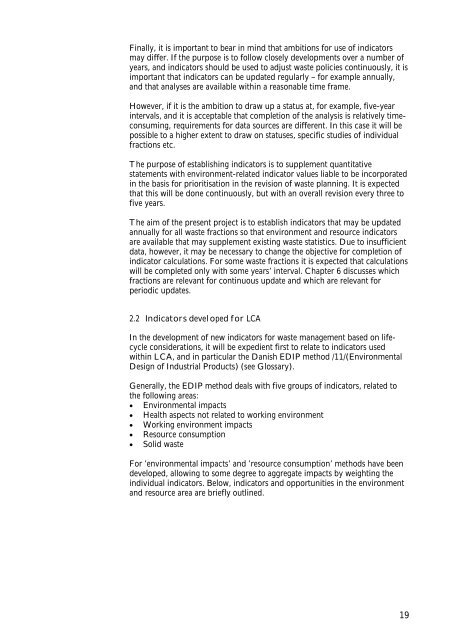Waste Indicators
Waste Indicators
Waste Indicators
Create successful ePaper yourself
Turn your PDF publications into a flip-book with our unique Google optimized e-Paper software.
Finally, it is important to bear in mind that ambitions for use of indicatorsmay differ. If the purpose is to follow closely developments over a number ofyears, and indicators should be used to adjust waste policies continuously, it isimportant that indicators can be updated regularly – for example annually,and that analyses are available within a reasonable time frame.However, if it is the ambition to draw up a status at, for example, five-yearintervals, and it is acceptable that completion of the analysis is relatively timeconsuming,requirements for data sources are different. In this case it will bepossible to a higher extent to draw on statuses, specific studies of individualfractions etc.The purpose of establishing indicators is to supplement quantitativestatements with environment-related indicator values liable to be incorporatedin the basis for prioritisation in the revision of waste planning. It is expectedthat this will be done continuously, but with an overall revision every three tofive years.The aim of the present project is to establish indicators that may be updatedannually for all waste fractions so that environment and resource indicatorsare available that may supplement existing waste statistics. Due to insufficientdata, however, it may be necessary to change the objective for completion ofindicator calculations. For some waste fractions it is expected that calculationswill be completed only with some years’ interval. Chapter 6 discusses whichfractions are relevant for continuous update and which are relevant forperiodic updates.2.2 <strong>Indicators</strong> developed for LCAIn the development of new indicators for waste management based on lifecycleconsiderations, it will be expedient first to relate to indicators usedwithin LCA, and in particular the Danish EDIP method /11/(EnvironmentalDesign of Industrial Products) (see Glossary).Generally, the EDIP method deals with five groups of indicators, related tothe following areas:• Environmental impacts• Health aspects not related to working environment• Working environment impacts• Resource consumption• Solid wasteFor ’environmental impacts’ and ’resource consumption’ methods have beendeveloped, allowing to some degree to aggregate impacts by weighting theindividual indicators. Below, indicators and opportunities in the environmentand resource area are briefly outlined.19
















